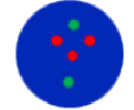Product Cat. No.: GBS-118
For Research Use Only
RREB1 gene amplification probe reagent..
10 Tests/box
This kit uses orange fluorescein to label RREB1 orange probe and green fluorescein to label CEP6 probes. RREB1/CEP6 dual color probe can be combined with the target detection site by in situ hybridization.
This kit consists of RREB1/CEP6 dual color probe, as shown in Table 1.
| Component name | Specifications | Quantity | Main components |
|---|---|---|---|
| RREB1/CEP6 dual color probe | 100μL/Tube | 1 | RREB1 orange probe ; CEP6 green probe |

Keep sealed away from light at -20oC±5oC. The product is valid for 12 months. Avoid unnecessary repeated freezing and thawing thatshould not exceed 10 times. After opening, within 24 hours for short-term preservation, keep sealed at 2-8oC in dark. For long-term preservation after opening, keep the lid sealed at -20oC±5oC away from light. The kit is transported under 0℃.
Fluorescence microscopy imaging systems, including fluorescence microscopy and filter sets suitable for DAPI (367/452), Green (495/517), and Orange (547/565).

Negative : 2 orange 2 green

Positive : n orange 2 green (n<=1)
V1. 0: Approval date: November 01, 2022
